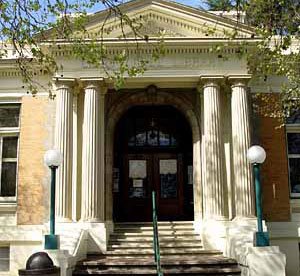Keeping the museum open is high up on Connie Rogers’ Christmas
list.
GILROY
Keeping the museum open is high up on Connie Rogers’ Christmas list.
As the president of the Gilroy Historical Society and the go-to person for resolving all those obscure, late-night dinner debates about who did what in Gilroy when, Rogers could not stand by and watch the museum expire along with the employment of 47 city workers.
So last week she sent Christmas cards to 130 society members and about 30 more residents asking them to volunteer at the museum, which houses more than 25,000 documents, trinkets and collectibles detailing everything from the Ohlone Indians to Gilroy’s notable athletes.
So far only five people – including Councilman Bob Dillon and his companion, Library Commissioner Phyllis Armenta – have volunteered, but Rogers, who leads walking tours through Gilroy’s historic districts, said she expects more after the busy holiday season. She hopes to have a nascent trust fund and enough residents trained and ready to take over by Feb. 1. That’s when layoff notices go into effect, so Recreation Coordinator Susan Voss and part-time Museum Assistant Tom Howard will have to leave the band of volunteers in charge of the classic revival style building at the corner of Fifth and Church streets.
“We’re hoping the volunteers will be well trained, and if they are, hopefully there won’t be any problems,” Howard said. The part-timer has worked at the museum for eight years and said he had never heard of it closing throughout its 50-year history. Now it’s up to volunteers to continue that streak, and while they will surely run into snags, especially when it comes to finances, Rogers said she remains cautiously confident.
“We’re sort of feeling as we go here,” Rogers said. “What we envision is trying to continue the current programs as best we can, especially the school tours. Last year 400 third graders came to the museum.”
Those students perused a well-lit, air-conditioned museum with modern archiving software, meticulously organized files, clean window panes, vacuumed floors and a staff of two who could draw the building’s floor plan in their sleep. While Voss and Howard are central to the museum’s operation, Recreation Manager Maria De Leon said volunteers alone could not save the museum because the majority of its budget pays for maintenance and other non-personnel expenses.
“I’m hoping to connect with the volunteers, but the majority of the museum’s cost is for maintaining that facility and keeping it clean,” De Leon said.
After taking out about $16,000 for Howard’s work and the extra hours put in by other part-timers during special events, the museum spends the remainder of its $107,534 budget on cleaning, electricity, heating, an alarm system, updating software and microfilm, according to De Leon. Because Voss divides her time between the museum and the city’s Community Services Department, the museum’s budget also pays a portion of her salary, which totals $81,614, including benefits, according to city figures.
Students may have to keep their coats on next time they visit, but Rogers said a soon-to-be endowment fund could help pay the extra costs.
“The museum is the last thing on the city’s priority list, and I don’t argue with that because things like police and fire and water and sewer – those, of course, have to come first,” Rogers said.
To kick start the Gilroy Museum Endowment Trust Fund, Rogers and other history buffs have turned to Kaiser Wilhelm II, the deceased ruler of Prussia and the German Empire.
Last year the city council approved the auction of a vase depicting the autocrat, which found its way to the Gilroy Museum thanks to Edwin Driscoll Jr. The former resident acquired it at an auction in Canada and then donated it to the city before he moved in 1975, according to the museum. Doyle New York will host the auction in Manhattan come February, and Rogers said she expects the 44-inch tall vase to fetch at least a few thousand dollars. But last year, Cathy Mirelez, the city’s cultural arts and museum supervisor, guessed closer to $35,000 or $40,000.
“Maybe it won’t be so bad because the rich people who collect those things are not like us,” Rogers said.
Whether it’s $3,000 or $30,000, the Historic Society will work with the city to grow the nest egg, Rogers said. Until then, it is all about finding those volunteers like Councilman Dillon.
“I’m a big supporter of the museum, and I certainly regret that the funds aren’t available, but it’s valuable to the community, and I can afford three or four hours a couple of times a week,” Dillon said. “The worst thing that could happen is you get to sit around and read old newspapers for four hours.”
So far saving the museum has not seemed to anger the local chapter of the American Federation of State, County, and Municipal Employees, which represents 126 Gilroy employees, including Voss. Some city officials anticipated AFSCME opposing the idea of volunteers replacing a dues paying union member who’s on her way out the door. Rogers has heard similar concerns, but so far, she has heard nothing from them.
“There are a lot of people here who have told me they’ll help and that they’re interested,” Rogers said. “Now, I just want to see their applications.”
Visit the Dispatch online to download an application or visit the Community Services Department at City Hall, 7351 Rosanna St.













